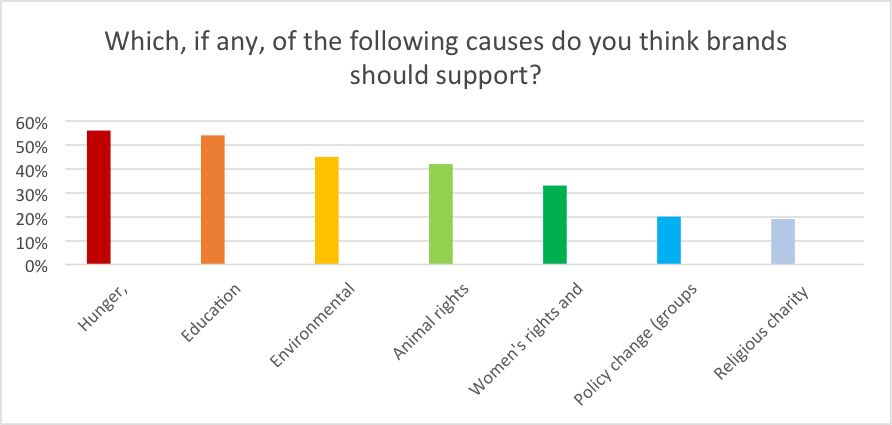According to Organ (2017), cause-related marketing, or cause marketing, is defined as “a type of Corporate Social Responsibility (CSR) in which a company’s promotional campaign has the dual purpose of increasing profitability while bettering society.” In other words, “Cause Marketing occurs when a company does well by doing good.” Cause Marketing may happen as the result of “the cooperative efforts of a for-profit business and a non-profit organization for mutual benefit” (Organ, 2017).
Examples of Cause Marketing
For instance, General Mills, Yoplait’s parent, cooperated with Susan G. Komen’s Race for the Cure series and donated 10 cents to the campaign based on consumers of its yogurt cups sending in a pink lid. This cooperation between a for-profit and a non-profit organization that lasted more than 15 years provided more than $50 million to the Cure campaign (Hessekiel, 2017). Another example is the Campbell’s Labels for Education Campaign which ran for more than 42 years and contributed more than $110 million in school supplies every time a consumer sent in the special LFE codes on the labels (Hessekiel, 2017). TOMS shoes provide another cause marketing example that has implemented the ‘one-for-one’ campaign, donating a pair of shoes once a pair of TOMS shoes is purchased by a customer.
Why Is Cause Marketing Effective?
Consumers love to participate in cause-related marketing campaigns and purchase from companies who offer such opportunity. Advances in mobile technology and the internet have brought the world closer. Consumers are more aware of those who need help and therefore are more willing to make a difference by cooperating with businesses and brands who have decided to help those in need. By doing good, consumers feel philanthropic while purchasing something as simple as a cup of yogurt or a pair of shoes. Cause-related marketing campaigns are also advantageous for for-profit businesses. If executed correctly, a cause marketing campaign will provide positive public reputation, wider marketing opportunities, and more profit for businesses.
Finally, non-profits will also benefit from engaging in a cause marketing campaign. They can use the financial resources of the for-profits to reach a larger audience and promote their cause. More people will be aware of their campaign, resulting in more money donated to their cause.
What Do Customers Think of Cause Marketing?
New survey results by marketing research firm Toluna reveals interesting ideas about how consumers think about cause marketing. For instance, about two thirds of respondents said that they regularly or sometimes actively seek out brands that donate to certain causes (Bazilian, 2017). Also, among millennials, Generation X, and Boomers, millennials showed the most willingness to support a brand aligned with a cause by doing the following activities:
- Spending more time to research brands donating to causes
- Being willing to pay more for the products
- Sacrificing on the quality of the products for a good cause
Interestingly, when the respondents were asked about the type of causes they think brands should support, the top picks were hunger, homelessness and medical relief, education, and the environment. Look below for other categories of causes and the respondents’ votes on them (Bazilian, 2017).

Elements of Successful Cause Marketing Campaigns
Successful cause marketing campaigns have several elements.
1) Simple and Straightforward
The message of the campaign should be compelling and simple. Also, if there is a partnership between a for-profit and a non-profit, the link should be clear and understandable for customers: such as Staples and education or TOMS Eyewear and the gift of sight.
2) Commitment
Customers need to feel the commitment of the companies to the cause before they decide to spend for the cause. Businesses that show long-term commitment and demonstrate how their brand is connected to the cause will receive better responses from customers. P&G’s global marketing and brand building officer Marc Pritchard says, “Building brands that serve a higher purpose produce better business results. Brands like Pampers and Tide have consistently delivered double-digit sales growth” (Semons, 2017).
3) Multiple Media Channels
Successful campaigns don’t just rely on one type of media. They use different media types such as TV, radio, magazines, outdoor displays, and social media to reach as many people as possible. Various media not only help with spreading the word, but also help to address different types of audiences and generations who use different methods to stay connected.
4) Request an Action
When customers are asked to do a specific task, they are more motivated to participate, since doing a small personal action allows them to show their commitment to the cause they are supporting. One of the best examples for this idea is the ALS Ice Bucket challenge in which people were asked to dump a bucket of ice water over their heads, film what they did, share it on social media, and challenge three friends to join the campaign to raise awareness. They are also asked to donate money to the ALS association to support research. The simple and fun action of the campaign was so effective that it was a hit on social media for a while and successfully raised $115 million for the ALS Association (Rogers, 2016).
Cause marketing, if designed and implemented correctly, can provide a great opportunity for businesses to build strong brands and reputation. It can also help non-profits to raise awareness and generate money, while offering customers a chance to contribute and support the causes they find valuable.
--
Written by Dr. Avisha Sadeghinejad, Program Chair, and Bill Davis MA, CM, CDM.
References
Bazilian, E. (2017, March 12). Infographic: What Consumers Really Think About Cause Marketing. Adweek. Retrieved from http://www.adweek.com/brand-marketing/infographic-what-consumers-really-think-about-cause-marketing/
Hessekiel, D. (2017). Four Cause Marketing Classics Passed Last Year—And A New Era Began. Forbes. Retrieved from https://www.forbes.com/sites/davidhessekiel/2017/04/18/four-cause-marketing-classics-passed-last-year-and-a-new-era-began/#315ea9597e8d
Organ, M. (2017, May 23). Cause Marketing-Definition. Retrieved from https://causemarketing.com/research/cause-marketing-definition/
Rogers, K. (2016, July 27). The ‘Ice Bucket Challenge’ Helped Scientists Discover a New Gene Tied to ALS. The New York Times. Retrieved from https://www.nytimes.com/2016/07/28/health/the-ice-bucket-challenge-helped-scientists-discover-a-new-gene-tied-to-als.html
Semons, A. (2017, March 12). 4 Keys to Creating Cause Marketing That Benefits Both Brands and Nonprofits. Adweek. Retrieved from http://www.adweek.com/brand-marketing/4-keys-to-creating-cause-marketing-that-benefits-both-brands-and-nonprofits/
